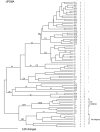Clonality and recombination in genetically differentiated subgroups of Cryptococcus gattii
- PMID: 16087745
- PMCID: PMC1214530
- DOI: 10.1128/EC.4.8.1403-1409.2005
Clonality and recombination in genetically differentiated subgroups of Cryptococcus gattii
Abstract
Cryptococcus gattii is a pathogenic yeast that together with Cryptococcus neoformans causes cryptococcosis in humans and animals. High numbers of viable C. gattii propagules can be obtained from certain species of Australian Eucalyptus camaldulensis trees, and an epidemiological link between Eucalyptus colonization and human exposure has been proposed. However, the highest prevalence of C. gattii cryptococcosis occurs in Papua New Guinea and in regions of Australia where the eucalypt species implicated to date are not endemic. This study investigated the population structure of three geographically distinct clinical and veterinary populations of C. gattii from Australia and Papua New Guinea. All populations that consisted of a genotype found frequently in Australia (VGI) were strongly clonal and were highly differentiated from one another. Two populations of the less common VGII genotype from Sydney and the Northern Territory had population structures inferring recombination. In addition, there was some evidence of reduced genetic differentiation between these geographically remote regions. In a companion study presented in this issue, VGII isolates were overwhelmingly more fertile than those of the VGI genotype, giving biological support to the indirect assessment of sexual exchange. It appears that the VGI genotype propagates clonally on eucalypts in Australia and on an unknown substrate in Papua New Guinea, with infection initiated by an unidentified infectious propagule. VGII isolates are completing their life cycles and may be dispersed via sexually produced basidiospores, which are also likely to initiate respiratory infection.
Figures



Similar articles
-
Clonality and α-a recombination in the Australian Cryptococcus gattii VGII population--an emerging outbreak in Australia.PLoS One. 2011 Feb 24;6(2):e16936. doi: 10.1371/journal.pone.0016936. PLoS One. 2011. PMID: 21383989 Free PMC article.
-
Jet-Setting Koalas Spread Cryptococcus gattii VGII in Australia.mSphere. 2019 Jun 5;4(3):e00216-19. doi: 10.1128/mSphere.00216-19. mSphere. 2019. PMID: 31167945 Free PMC article.
-
Evidence of recombination in mixed-mating-type and alpha-only populations of Cryptococcus gattii sourced from single eucalyptus tree hollows.Eukaryot Cell. 2008 Apr;7(4):727-34. doi: 10.1128/EC.00020-08. Epub 2008 Feb 15. Eukaryot Cell. 2008. PMID: 18281600 Free PMC article.
-
Ecology, life cycle, and infectious propagule of Cryptococcus neoformans.Lancet. 1990 Oct 13;336(8720):923-5. doi: 10.1016/0140-6736(90)92283-n. Lancet. 1990. PMID: 1976940 Review.
-
Looking for sex in the fungal pathogens Cryptococcus neoformans and Cryptococcus gattii.FEMS Yeast Res. 2006 Jun;6(4):588-98. doi: 10.1111/j.1567-1364.2006.00087.x. FEMS Yeast Res. 2006. PMID: 16696654 Review.
Cited by
-
Cryptococcus neoformans mates on pigeon guano: implications for the realized ecological niche and globalization.Eukaryot Cell. 2007 Jun;6(6):949-59. doi: 10.1128/EC.00097-07. Epub 2007 Apr 20. Eukaryot Cell. 2007. PMID: 17449657 Free PMC article.
-
First reported case of Cryptococcus gattii in the Southeastern USA: implications for travel-associated acquisition of an emerging pathogen.PLoS One. 2009 Jun 10;4(6):e5851. doi: 10.1371/journal.pone.0005851. PLoS One. 2009. PMID: 19516904 Free PMC article.
-
Clonality and α-a recombination in the Australian Cryptococcus gattii VGII population--an emerging outbreak in Australia.PLoS One. 2011 Feb 24;6(2):e16936. doi: 10.1371/journal.pone.0016936. PLoS One. 2011. PMID: 21383989 Free PMC article.
-
Isolates of Cryptococcus neoformans from infected animals reveal genetic exchange in unisexual, alpha mating type populations.Eukaryot Cell. 2008 Oct;7(10):1771-80. doi: 10.1128/EC.00097-08. Epub 2008 Jun 13. Eukaryot Cell. 2008. PMID: 18552280 Free PMC article.
-
Asexual propagation of a virulent clone complex in a human and feline outbreak of sporotrichosis.Eukaryot Cell. 2015 Feb;14(2):158-69. doi: 10.1128/EC.00153-14. Epub 2014 Dec 5. Eukaryot Cell. 2015. PMID: 25480940 Free PMC article.
References
-
- Agapow, P.-M., and A. Burt. 2001. Indices of multilocus linkage disequilibrium. Mol. Ecol. Notes 1:101-102.
-
- Ali, S., C. R. Muller, and J. T. Epplen. 1986. DNA finger printing by oligonucleotide probes specific for simple repeats. Hum. Genet. 74:239-243. - PubMed
-
- Boekhout, T., B. Theelen, M. Diaz, J. W. Fell, W. C. J. Hop, E. C. A. Abeln, F. Dromer, and W. Meyer. 2001. Hybrid genotypes in the pathogenic yeast Cryptococcus neoformans. Microbiology 147:891-907. - PubMed
-
- Brown, J. K. M., and M. S. Hovmoller. 2002. Aerial dispersal of pathogens on the global and continental scales and its impact on plant disease. Science 297:537-541. - PubMed
Publication types
MeSH terms
LinkOut - more resources
Full Text Sources

